Mysterious Ground Ice Feature
TOOLIK FIELD STATION, ALASKA– Earlier this summer, my friends and I encountered a curious ice feature north of Toolik Lake near the Kuparuk River. While we all study in the Arctic, none of us are too familiar with permafrost dynamics. Since the ice feature occurs at a familiar site, we knew it was newly exposed ice. So, we set out to learn just what this feature is and how it formed.
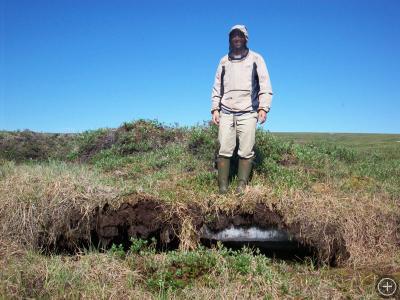
Ken Fortino stands atop the ice feature in his bug jacket. Ken and Dendy Lofton first noticed exposed ice beneath the tundra in late-June.
Our first question was, ‘How old is this ice? Has it existed since the last glacial maximum (~25,000 years ago)?’ This was the late-Pleistocene epoch – the most recent Ice Age when large mammals, such as woolly mammoths, scimitar cats and the giant beaver, roamed in the far north.
To find out, I contacted Dr. Skip Walker at UAF’s Alaska Geobotany Center. Dr. Walker recently lead a field trip in northern Alaska for the 9th International Permafrost Conference that was held in Fairbanks in late June.
The Arctic is underlain by continuous permafrost. These soils remain perennially frozen. However the upper-most layer of the tundra, or the active layer, thaws each summer. Plant roots penetrate the active layer and a suite of insects, fungi and microbes thrive within these annually thawed soils. The depth of the active layer varies across the tundra landscape. At Toolik Lake, the average maximum thaw depth in early August is about 75 cm.
An important landscape feature that influences the depth of the active layer is the overlying plant community. For example, in the tundra within the vicinity of the field station those areas with peat moss (Sphagnum spp.) will have a shallow depth of thaw. The peat moss insulates the permafrost below and these soils remain largely frozen. For this reason, a simple disturbance of the tundra vegetation can significantly affect the permafrost beneath.
When the permafrost thaws extensively, large depressions can occur in the tundra. We call this phenomenon “thermokarst.” Thermokarst originates when the ice-rich permafrost thaws and the ground beneath collapses. On slopes and riverbanks, thermokarst results in chunks of tundra sloughing into the valleys below.

Last week, we took advantage of a snow day to visit the ice feature again. The site is accessible via the maintenance road that parallels the Trans-Alaska Pipeline north to the oil fields at Prudhoe Bay on the Arctic Ocean.
I sent Dr. Walker these photos and identified the ice as, ‘a curious ground ice feature.’
His e-mail response began, “Oh, that’s a CGIF.”
I panicked and thought to myself, “What’s a CGIF? Is that an acronym I should be familiar with?”
I re-read my initial inquiry and realized CGIF was an acronym for our original terminology; ‘curious ground ice feature.’
We learned from Dr. Walker that this ice is not old. It likely formed over the previous year. Dr. Walker hypothesized that these features form when water flows between the peat moss and the mineral soil. This water then freezes and the tundra heaves upward during the winter months. Apparently, these types of ice features are quite common in the northern foothills of the Brooks Range.
Although CGIFs are common, they do not have a formal name. Collectively, the field trip participants called them, ‘ice-cored mounds.’
I must admit, I was disappointed that the ice was so young. I yearn for a glimpse of the last Ice Age. While I may never see a live giant beaver, it is still possible that I will one day see, touch and taste ice that formed during the late Pleistocene.
Yup, I did indeed eat an ice-cube size chunk of the CGIF.



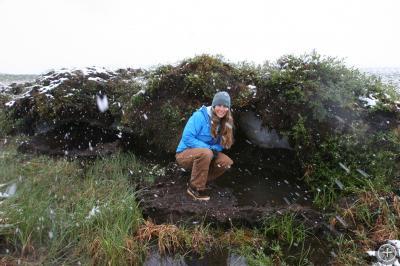
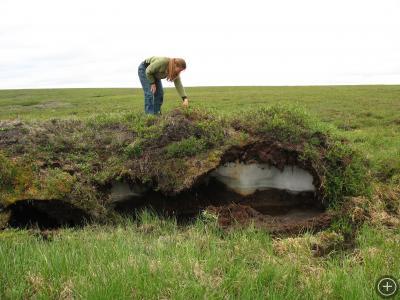
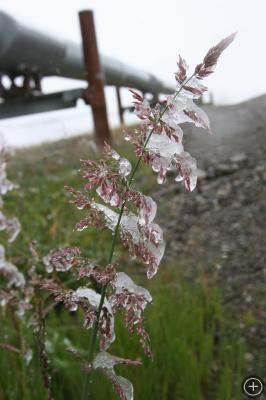



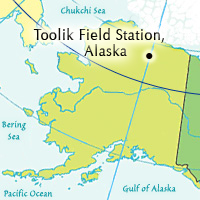





So i was wondering for a college asignment, if this type of feature can occur, is it not logical that the same type of ice mound could occur but on a much larger scale, possibly being as old as you had hoped this one to be? also is there a tool of some sort that you can use to “sonar” the ground or something to determine if an ordinary mound has an ice core?
Thank you,
Avi Schochet
Hello Amy,
Have you ever found ice from the Pleistocene epoch period? Also what are the main differences from the plants in the open-top green houses and in their natural ecosystems?
Hello Avi,
Ice features do occur in the Arctic that are quite old; certainly as old as the last glacial maximum (~25,000 years ago). The most common true perennial permafrost mounds are are pingos and palsas. These phenomena both result from freezing of water to an ice core. When I first saw the ice feature described in this dispatch I assumed it was a palsa.
I am not aware of sonar-like tool to determine the nature of a mound amongst the tundra (ice vs. permafrost). It is a very interesting idea, however.
Good luck with assignment.
Best,
Amy
Hello Liz,
I have not seen ice from the late-Pleistocene epoch.
However, I have encountered pingos in the Alaskan Arctic. Some pingos are nearly that old. One of the most prominent pingos, is Betty Pingo. It is located within the oil fields at Prudhoe Bay. However, I don’t know the age of this particular pingo.
To see digital elevation model images of Betty Pingo visit this page and scroll to the very bottom: http://www.uaf.edu/water/faculty/nolan/kuparuk/drmatt_kup_agu.htm
Or, see this image: http://www.uaf.edu/water/projects/NorthSlope/coastal_plain/images/2001_snowmelt/Betty-Pingo/bp-pingo.061700.1232.jpg
The latter image is looking north to the pingo.
As you can imagine, these are significant topographic features on the coastal plain.
I plan to address your second question, how the vegetation differs in the greenhouse chambers from surrounding tundra, in an upcoming dispatch. In summary, the vegetation in the chambers is larger (both taller and has greater biomass) and the timing of stages such as flowering and fruiting is earlier.
Thanks for your interest in our project.
Best,
Amy